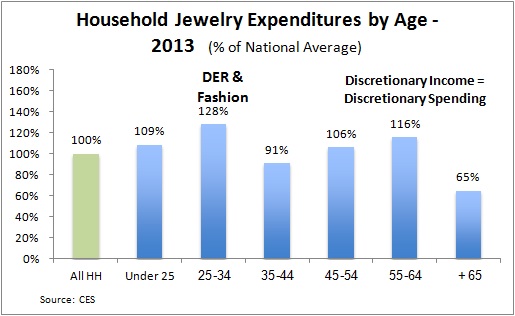IDEX Online Research: Young U.S. Shoppers Drove Jewelry Spending in 2013
November 29, 14
Millennial American consumers – particularly those between ages 25 and 34 – spent more on jewelry than any other age group in 2013, according to newly released data from the government’s Consumer Expenditure Survey.
This is a continuation of a trend that began in the recession of 2008-2010, when Millennial shoppers out-spent Boomers and other older shoppers for the first time in history. The graph below illustrates the relative spending levels for jewelry by age group in 2013.

Factors Driving Millennial Spending on Jewelry
There are several factors that have been driving Millennial consumers into jewelry stores, including the following:
· Millennial shoppers are “tuned” to seek fashion accessories, including fashion jewelry.
· Millennial consumers are the sweet spot for diamond engagement ring (DER) sales, since the average age at which couples are marrying is between 25 and 30 years old.
· Millennial shoppers want “flash for cash” – lots of bling including multiple stones and various alternative metals for their jewelry.
· Millennial shoppers don’t want what their Boomer moms wanted. Boomers thought “bigger is better”, Millennial consumers want something that’s “different”.
· Millennial consumers have good, high-paying jobs in the tech field, and have been immune to layoffs which characterized other occupations, particularly during the recession.
· Millennial consumers generally don’t have the responsibilities of a family or homeownership, since they have put off assuming these responsibilities until later in life, unlike their Boomer parents who generally formed households at a much younger age.
· In the recession, Millennial consumers didn’t have stock portfolios which suffered dramatic losses. In short, they barely felt the recession.
· The optimistic outlook that characterized the Millennial consumers in the recession continues today.
Boomers Have Been Edged Out By Millennial Jewelry Shoppers
Historically, older consumers were the big spenders for jewelry. They were at their peak earning years, their home mortgages were paid off, the kids’ college bills were paid, and they had more money than at any other time of their life. Research has confirmed that high-income households spend disproportionally more on jewelry than lower income households. The graph below illustrates the pre-recession jewelry spending by age group. American shoppers aged 55-64 were historically the largest spenders on jewelry; this graph shows historic jewelry spending trends before Boomers reached age 55.
.jpg)
However, Boomers’ jewelry expenditures have been disappointing in recent years. As Boomers have aged, their spending has not matched the levels of their parents. But, this is not to minimize the importance of Boomers to the U.S. jewelry industry.
In 2013, they were the second-largest group of consumers who spent money on jewelry. The impact of Boomer incomes and spending has been delayed, but could become more important over the next few years.